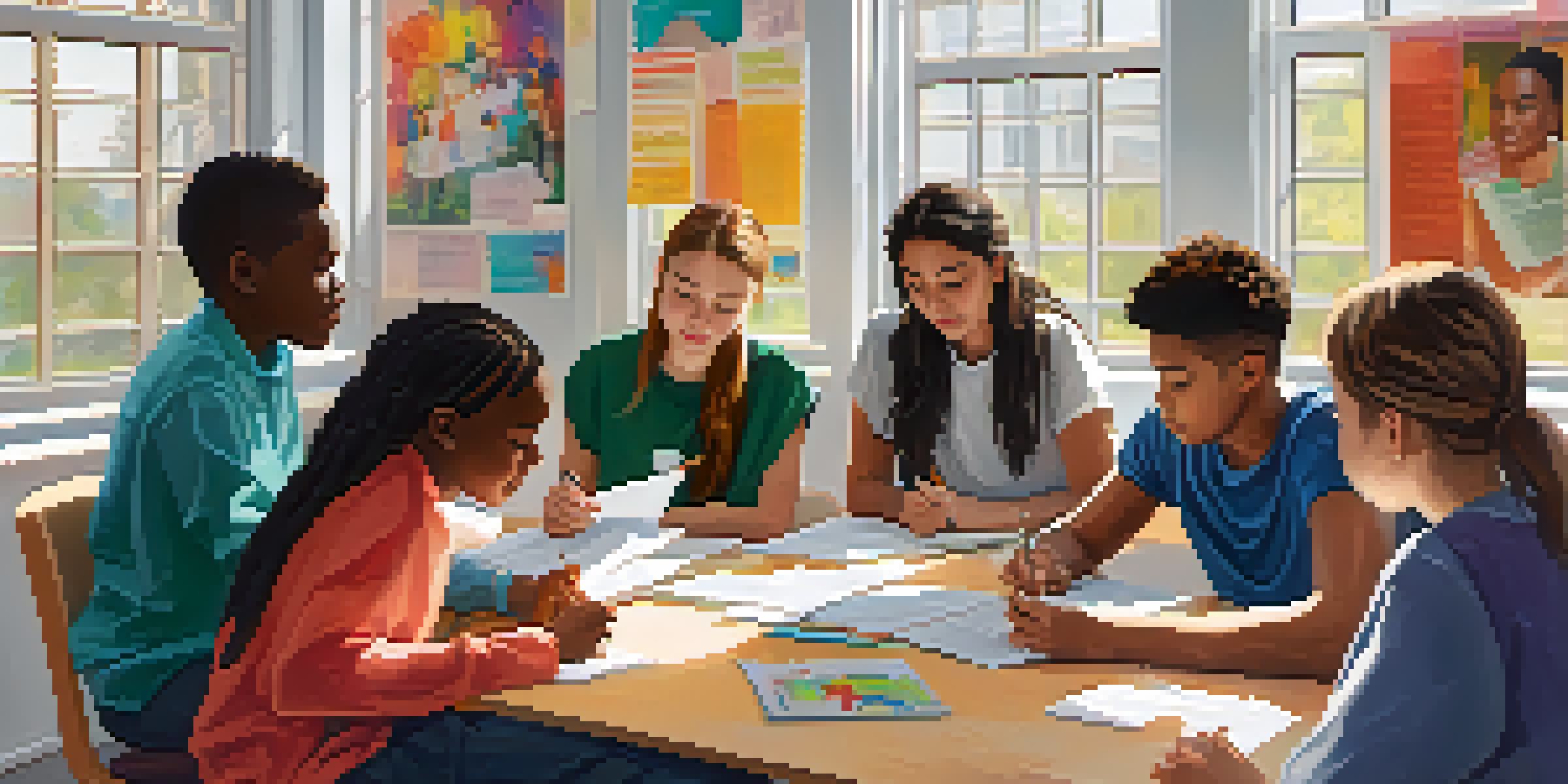Developing Strategies for Effective Peer Assessment

Understanding the Importance of Peer Assessment
Peer assessment is a powerful tool that fosters collaboration among students. It encourages learners to engage deeply with the material, as they must evaluate their peers' work critically. This process not only builds essential skills like communication and teamwork but also promotes a sense of accountability in students.
Feedback is the breakfast of champions.
Moreover, peer assessment helps to create a supportive learning environment where feedback is normalized. When students assess each other, they learn to provide constructive criticism, which is vital for personal and academic growth. This collaborative effort can lead to a richer understanding of the subject matter and enhance overall learning outcomes.
Incorporating peer assessment into educational strategies can also help educators gauge student understanding. By observing how students evaluate one another, teachers can identify common misconceptions and adjust their instruction accordingly. Ultimately, peer assessment is more than just a grading tool; it's a pathway to a deeper engagement with learning.
Setting Clear Objectives for Peer Assessment
To ensure successful peer assessment, it's crucial to establish clear objectives from the start. These objectives should outline what you want students to achieve, whether it’s improving critical thinking skills, enhancing collaboration, or mastering specific content areas. When students understand the goals, they are more likely to engage meaningfully with the process.

Additionally, clear objectives can serve as a guide for both students and educators throughout the assessment process. For instance, if the goal is to enhance feedback quality, students can focus on providing specific, actionable suggestions rather than vague comments. This clarity can lead to more productive discussions and a greater impact on learning.
Peer Assessment Boosts Learning
Engaging in peer assessment encourages collaboration and critical evaluation, enhancing students' understanding and accountability.
Moreover, having well-defined objectives helps in creating assessment criteria that are transparent and fair. Students can refer to these criteria when evaluating their peers, ensuring that everyone is on the same page. This transparency reduces anxiety and fosters a more positive atmosphere for peer assessment.
Creating a Structured Peer Assessment Framework
A structured framework is essential for effective peer assessment. This framework should include guidelines on how to conduct assessments, what criteria to use, and how to provide feedback. By having a clear structure, students can navigate the assessment process more confidently and effectively.
The greatest gift is not being afraid to question.
For example, you might introduce rubrics that outline specific evaluation criteria, such as clarity, organization, and depth of analysis. This not only provides students with a roadmap for their assessments but also ensures consistency in feedback. A well-designed rubric can demystify the evaluation process and empower students to assess their peers fairly.
Furthermore, a structured framework can incorporate training sessions that prepare students for the peer assessment process. Teaching students how to give and receive feedback can significantly enhance the quality of the assessments. By equipping them with these skills, you set the stage for a more enriching learning experience.
Encouraging Constructive Feedback Among Peers
Constructive feedback is the cornerstone of effective peer assessment. Encouraging students to focus on strengths as well as areas for improvement can create a more balanced and supportive atmosphere. This approach not only enhances their learning experience but also fosters a culture of respect among peers.
To promote constructive feedback, you can introduce specific strategies, such as the 'sandwich method'—starting with a positive comment, followed by suggestions for improvement, and ending with another positive remark. This technique softens the delivery of critiques, making them more palatable and encouraging a growth mindset among students.
Clear Objectives are Essential
Establishing clear objectives helps guide both students and educators, ensuring meaningful engagement in the peer assessment process.
Moreover, teaching students to ask open-ended questions can further enrich the feedback process. Questions like 'What did you find most effective in this work?' or 'How might this be improved?' can prompt deeper reflections. This interaction not only benefits the person receiving feedback but also strengthens the evaluator's critical thinking skills.
Fostering an Environment of Trust and Respect
Trust and respect are fundamental to successful peer assessment. Students must feel safe to express their thoughts and opinions, knowing that their feedback will be valued and taken constructively. Building this environment requires intentional efforts from educators and students alike.
One effective way to foster trust is by establishing ground rules for peer assessment sessions. These rules can include guidelines on confidentiality, respect for differing opinions, and the importance of constructive criticism. By creating a safe space, students are more likely to engage openly and honestly in the assessment process.
Additionally, sharing experiences and discussing the importance of feedback can help to cultivate respect among peers. Engaging students in conversations about their experiences with receiving and giving feedback can normalize the process. This dialogue not only enhances understanding but also strengthens relationships within the classroom.
Utilizing Technology to Enhance Peer Assessment
In today's digital age, technology can play a significant role in enhancing peer assessment. Various online platforms and tools can facilitate the process, making it more efficient and accessible. From collaborative document editors to specialized assessment software, technology offers a plethora of options for educators.
For instance, using online platforms allows students to provide feedback asynchronously, accommodating different schedules and learning styles. This flexibility can lead to more thoughtful and reflective assessments as students have time to consider their feedback. Additionally, many platforms allow for anonymous feedback, which can help to reduce anxiety and encourage honesty.
Technology Enhances Assessment
Utilizing technology in peer assessment streamlines the process, making it more efficient and accessible for students.
Moreover, technology can streamline the entire peer assessment process, from submission to evaluation. Automated systems can help track submissions and ensure that all students participate. By leveraging technology, educators can create a more dynamic and engaging peer assessment experience that resonates with today’s learners.
Reflecting on the Peer Assessment Experience
Reflection is a critical component of the peer assessment process. After completing assessments, students should have the opportunity to reflect on their experiences—what they learned, the feedback they received, and how they can improve moving forward. This reflection not only solidifies learning but also promotes continuous improvement.
Encouraging students to maintain a reflective journal can be a powerful way to capture their thoughts and insights. By documenting their experiences, students can track their growth over time and identify recurring themes in their feedback. This practice fosters a deeper understanding of their learning journey and empowers them to take ownership of their progress.

Moreover, educators can facilitate group discussions where students share their reflections. This collective exploration can lead to richer insights and foster a sense of community within the classroom. By prioritizing reflection, the peer assessment process becomes a valuable learning experience that extends beyond grades and evaluations.